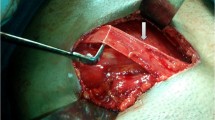Abstract
The author has developed a new operation technique based on the physiological principle that provides dynamic posterior wall for inguinal hernia repair. Results of the first series of 400 patients were published in 2001 (ANZ J Surg 71:241–244, 2001). Now the author has described the results of the second series of 860 patients having 920 hernias with follow-up for more than 7 years. An undetached strip of the external oblique aponeurosis (EOA) is sutured to the inguinal ligament below and the muscle arch above, behind the cord, to form a new posterior wall. External oblique muscle gives additional strength to the weakened muscle arch to keep this strip physiologically dynamic. In this prospective study, 920 inguinal hernia repairs were performed between August 1990 and December 2003 in 860 patients. Follow-up was done for 7 years. The main outcome measure was early and late morbidities and especially recurrence in a long-term follow-up. Mean patient age was 50.5 years (range 18–90). A total of 851 (98.95%) patients were operated under local or regional anesthesia; 838 (97.4%) patients were ambulatory with limited movements in 6 h and free movements in 18–24 h; 792 (92%) patients had a hospital stay of one night and 840 (97.6%) patients returned to normal activities within 1–2 weeks. Hematoma formation requiring drainage was observed in one patient, while seven patients had wound edema during the postoperative period which subsided on its own. Follow-up was completed in 623 patients (72.5 %) by clinical examination or questionnaire. The median follow-up period was 7.8 years (range 1–12 years). There was no recurrence of hernia or postoperative neuralgia. This operation is simple to perform, does not require foreign body like a mesh or complicated dissection of the inguinal floor as in Bassini/Shouldice. It has shown excellent results with virtually zero recurrence rates.


Similar content being viewed by others
References
Desarda MP (2001) New method of inguinal hernia repair—a new solution. ANZ J Surg 71:241–244
Kingsnorth AN, Gray MR, Nott DM (1992) Prospective randomized trial comparing the Shouldice technique and plication darn for inguinal hernia. Br J Surg 79:1068–1070
Kux M, Fuchsjager N, Schemper M (1994) Shouldice is superior to Bassini inguinal herniorrhaphy. Am J Surg 168:15–18
Desarda MP (2003) Surgical physiology of inguinal hernia repair—a study of 200 cases. BMC Surgery 3:2
Amid PK, Shulman AG, Lichtenstein L (1991) Femoral hernia resulting from inguinal herniorrhaphy—the ‘plug’ repair. Contemp Surg 39:19–24
Hay JM, Boudet MJ, Fingerhut A et al (1995) Shouldice inguinal hernia repair in the male adult: the gold standard? A multicentre controlled trial in 1578 patients. Ann Surg 222:719–727
Panos RG, Beck DE, Maresh JN, Harford FJ (1992) Preliminary results of a prospective randomized study of Cooper’s ligament vs Shouldice herniorrhaphy technique. Surg Gynecol Obstet 175:315–319
Amid PK, Lichtenstein IL (1997) Lichtenstein open tension free hernioplasty. In: Maddern GJ, Hiatt JR, Philips EH (eds) Hernia repair (open vs. laparoscopic approaches). Churchill Livingstone, Edinburgh, pp 117–122
Zimmerman LM (1952) Recent advances in surgery of inguinal hernia. Surg Clin North Am 32:135–154
Author information
Authors and Affiliations
Corresponding author
Rights and permissions
About this article
Cite this article
Desarda, M.P. Physiological repair of inguinal hernia: a new technique (study of 860 patients). Hernia 10, 143–146 (2006). https://doi.org/10.1007/s10029-005-0039-1
Received:
Accepted:
Published:
Issue Date:
DOI: https://doi.org/10.1007/s10029-005-0039-1




